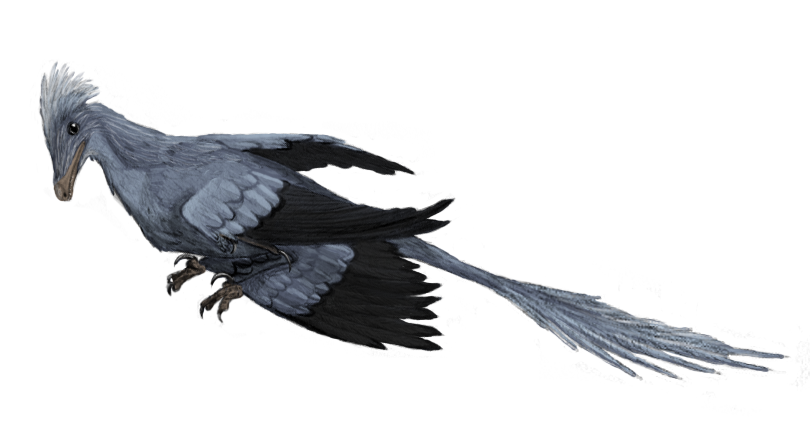home > natural history
Cryptovolans pauli
"Paul's hidden flyer"

Though it was first described in 2000, the true impications of (at the time) smallest known dinosaur Microraptor didn't become apparent until 2003. In 2002, a larger microraptorine named Cryptovolans was described with a few features not seen before in feathered dinosaur specimens from Liaoning, China. First, rather than the extensive "frond tail" of feathers seen in Archaeopteryx, where tail feathers (retrices) extended from tip to hip, Cryptovolans sported a "puff tail", a spray of feathers confined to the last third of the long, stiffened tail. Most surprisingly, Cryptovolans has long, vaned feathers stemming from the hind leg. I termed these structures "butt fans", as they seemed to be confined to the upper leg only, and (or so I speculated), may have opened and closed like a paper fan as the animal walked. Later specimens showed that these "butt fans" were not confined to the upper leg, but that the long feathers extended right down the lower leg and, shockingly, onto the metatarsas (upper foot), forming essentially a "hind wing." Even more specimens of microraptorians emerged and helped demonstrate that all of them likely had long foot feathers, now also known in the related Anchiornis and Pedopenna (and, possibly, in Sinornithosaurus).
Cryptovolans and its kin have been dubbed the "screaming biplane killers of the air", a title that refers to their hypothesized mode of gliding flight. Unable to splay the legs out sideways or to flap the wings to a significant degree, Cryptovolans would have had to sling the legs forward, hind wings beneath fore wings in a biplane-like configuration, to glide short distances between trees. Assuming they habitually climbed, that is. The lifestyle of these strange protobirds remains mysterious, and while they could likely climb trees as many animals can, studies of claw structure show they probably did not actually live in trees, so climbing and gliding may have been limited to escaping predators and possibly parachuting onto unuspecting prey.
Thanks to several beautifully preserved specimens, we know quite a bit about the feather types and configuration present inCryptovolans. Most Cryptovolans feathers were preserved in great detail, including its long, pointed, and asymmetrical outer primaries (indicating some aerodynamic function). The hind wings were more rounded in shape. At least one specimen preserves a crest of feathers on the head similar to Anchiornis, and another large fan of retrices (possibly used for display and/or to stabilize flight) on the last third of the tail.
For more onCryptovolans, see the Wikipedia article I helped edit.
Image License:
Creative Commons Attribution 3.0
You are free to Share (transmit, copy, and distribute) and to Remix (adapt or modify) the images on this page Under the following conditions: You must Attribute the work by giving written credit to Matt Martyniuk and linking to this Web site: http://www.azhdarcho.com (but not in any way that suggests that they endorse you or your use of the work).
For any reuse or distribution, you must make clear to others the license terms of this work. The best way to do this is with a link to this web page.Any of the above conditions can be waived if you get permission from the copyright holder. Nothing in this license impairs or restricts the author's moral rights.
DESCRIPTION
Length: 77cm (2.5ft)
Weight: 1kg (2lbs)
Location: Jiufotang Formation, Liaoning, China
Time: Aptian age, Lower Cretaceous (120 Ma)
CLASSIFICATION
Kingdom: Animalia
Phylum: Chordata
Class: Stem-Aves
Family: Ornithodesmidae
Genus: Microraptor
Species: M. pauli
SYSTEMATICS
Sauropsida
Diapsida
Archosauria
Ornithosuchia
Dinosauria
Theropoda
Coelurosauria
Maniraptora
Dromaeosauridae
